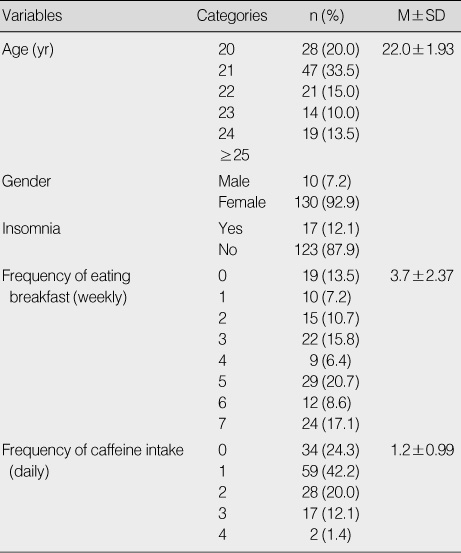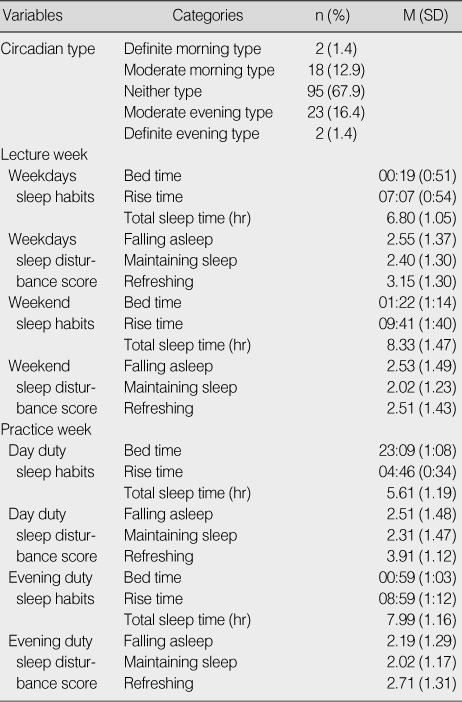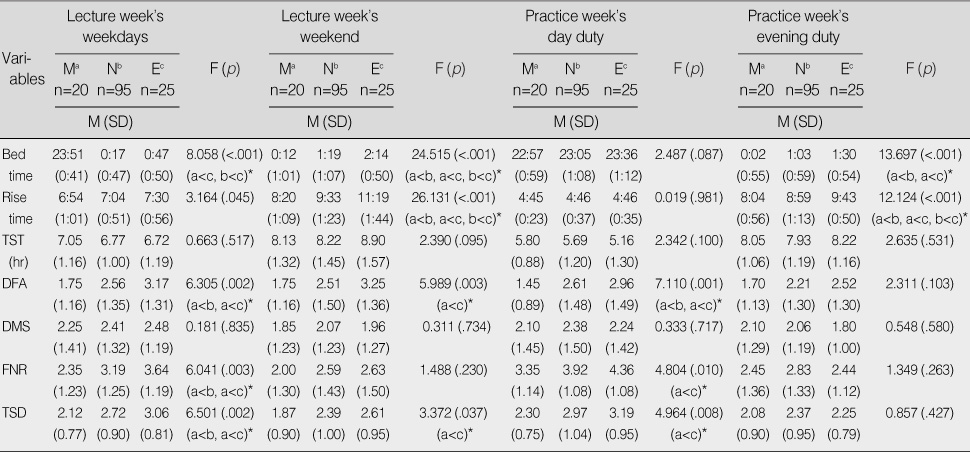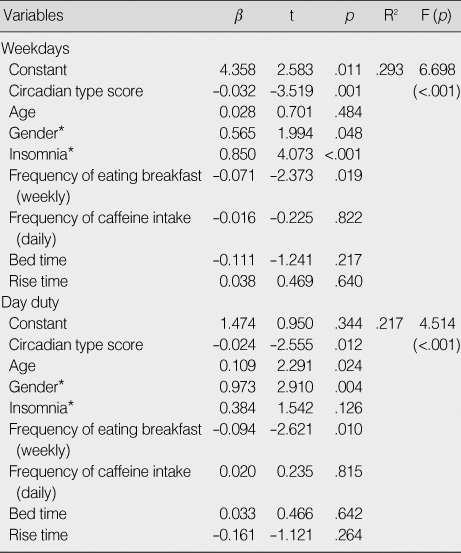Articles
- Page Path
- HOME > J Korean Acad Nurs > Volume 40(1); 2010 > Article
-
Original Article
- Sleep Patterns and Circadian Types of Nursing Students during Shift Schedules
- Hyun Sook Kim, Mi-Ran Eom, Eun-Kyung Kim
-
Journal of Korean Academy of Nursing 2010;40(1):43-51.
DOI: https://doi.org/10.4040/jkan.2010.40.1.43
Published online: February 28, 2010
1Assistant Professor, College of Nursing, Eulji University, Seongnam, Korea.
2Associate Professor, Department of Nursing, Mokpo National University, Muan, Korea.
3Assistant Professor, Department of Nursing, Mokpo National University, Muan, Korea.
- Address reprint requests to: Eom, Mi-Ran. Department of Nursing, Mokpo National University, 61 Dorim-ri, Cheongye-myeon, Muan 534-729, Korea. Tel: 82-61-450-2671, Fax: 82-61-450-2679, miran@mokpo.ac.kr
Copyright © 2010 Korean Society of Nursing Science
Abstract
-
Purpose
- The purpose of this study was to investigate sleep habits, sleep disturbance, and circadian types, and to identify factors influencing sleep disturbance in nursing students.
-
Methods
- Participants were 140 senior nursing students. The data were collected from May 19 to 27, 2008 using self-report questionnaires.
-
Results
- 1) Evening type delayed sleep-wake schedules were more frequent than for morning type, especially during weekend and evening shift duty. 2) In total sleep time, there were no significant statistical differences between morning type and evening type during weekdays, weekend, day or evening shift duty. 3) On weekdays and day shift duty, the mean score for sleep disturbance was significantly higher in the evening type compared to the morning type. 4) Sleep disturbance in weekday and day shift duty was influenced by circadian types, eating habits, and gender.
-
Conclusion
- The circadian types are a very important factor for determining the sleep quantity and quality in nursing students.
- 1. Akerstedt T. Psychophysiological effects of shift work. Scandinavian Journal of Environment and Health. 1990;16:67–73.
- 2. Brown FC, Buboltz WC, Soper B. Relationship of sleep hygiene awareness, sleep hygiene practices, and sleep quality in university students. Behavioral Medicine. 2002;28:33–38.ArticlePubMed
- 3. Chung MH, Chang FM, Yang CC, Kuo TB, Hsu N. Sleep quality and morningness-eveningness of shift nurses. Journal of Clinical Nursing. 2008;18:279–284.Article
- 4. Coleman RM. Wide awake at 3:00 A.M. By choice or by chance?. 1986;New York, NY, W. H. Freeman & Company.
- 5. Erdfelder E, Faul F, Buchner A. GPOWER: A general power analysis program. Behavior Research Methods, Instruments, & Computers. 1996;28:1–11.ArticlePDF
- 6. Forquer LM, Camden AE, Gabriau KM, Johnson CM. Sleep patterns of college students at a public university. Journal of American College Health. 2008;56:563–565.ArticlePubMed
- 7. Fossey E. Shiftwork can seriously damage your health. Professional Nurse. 1990;5:476–480.PubMed
- 8. Giannotti F, Cortesi F, Sevastiani T, Ottaviano S. Circadian preference, sleep and daytime behaviour in adolescence. Journal of Sleep Research. 2002;11:191–199.ArticlePubMed
- 9. Glazner LK. Shiftwork: Its effect on workers. The Official Journal of the American Association of Occupational Health Nurses. 1991;39:349–356.
- 10. Hawkins J, Shaw P. Self-reported sleep quality in college students: A repeated measures approach. Sleep. 1992;15:545–549.ArticlePubMed
- 11. Hilliker NA, Muehlbach MJ, Schweitzer PK, Walsh JK. Sleepiness/alertness on a simulated night shift schedule and morningness-eveningness tendency. Sleep. 1992;15:430–433.ArticlePubMed
- 12. Horne JA, Östberg O. A self-assessment questionnaire to determine morningness-eveningness in human circadian rhythms. International Journal of Chronobiology. 1976;4:97–110.PubMed
- 13. Hwang AR, Chung HS, Lim YS, Lee HW, Kim CJ. Effect of shift interval for the clinical nurse on the circadian rhythm. Journal of Korean Academy of Nursing. 1991;21:129–149.ArticlePDF
- 14. Kim HS. Comparison of the circadian types in non-shift workers and shift workers. Holy Spirit Junior College of Nursing Thesis Collection. 1994;6:96–104.
- 15. Kim HS, Jeong DU. Time-related changes in sleep-wake pattern as correlates of controlled shiftwork rotating directions. Seoul Journal of Medicine. 1993;34:301–309.
- 16. Kim JK. Circadian rhythm and psychological adjustment. Korean Journal of Health Psychology. 1998;3:129–140.
- 17. Kim JK, Song HS. The relation of circadian sleep phase preference to sleep habits, psychological adjustment and academic performance in college students. Korean Journal of Health Psychology. 2007;12:631–648.Article
- 18. Kryger MH, Roth T, Carskadon M. Kryger MH, Roth T, Dement WC. Circadian rhythms in humans: An overview. In: Principles and practice of sleep medicine. 1994;Philadelphia, PA, W. B. Saunders. 301–308.
- 19. Kwon GJ. A study on shift work nurses' sleeping pattern according to their fatigue level and working type. 2005;Seoul, Ewha Womans University. Unpublished master's thesis.
- 20. Lee SS, Kim DH. An evaluation of shift-worker's sleep and social life by chrono-type. The Journal of Daehan Association of Business Administration. 2003;16:2087–2098.
- 21. Lim NY. Effect of shift rotation on the circadian. 1985;Seoul, Yonsei University. Unpublished doctoral dissertation.
- 22. Miles L. Sleep questionnaire and assessment of wakefulness. 1979;Palo Alto, CA, Stanford Sleep Disorder Clinic.
- 23. Min S, Moon DS, Im WB. Effect of rapid rotating shift work on the urinary NA+, K+, and Cl-. Journal of Korean Academy of Nursing. 1998;28:869–880.ArticlePDF
- 24. Monk TH. Kryger MH, Roth T, Dement WC. Shift work. In: Principles and practice of sleep medicine. 1994;Philadelphia, PA, W. B. Saunders. 471–475.
- 25. Paine SJ, Gander PH, Travier N. The epidemiology of morningness/eveningness: Influence of age, gender, ethnicity, and socioeconomic factors in adults (30-49 years). Journal of Biological Rhythms. 2006;21:68–76.ArticlePubMedPDF
- 26. Russo PM, Bruni O, Lucidi F, Ferri R, Violani C. Sleep habits and circadian preference in Italian children and adolescents. Journal of Sleep Research. 2007;16:163–169.ArticlePubMed
- 27. Stuart GW, Laraia MT. Principles and Practice of Psychiatric Nursing. 1998;6th ed. St. Louis, MO, Mosby.
- 28. Taillard J, Philip P, Coste O, Sagaspe P, Bioulac B. The circadian and homeostatic modulation of sleep pressure during wakefulness differs between morning and evening chronotypes. Journal of Sleep Research. 2003;12:275–282.ArticlePubMed
- 29. Zorick F. Kryger MH, Roth T, Dement WC. Insomnia. In: Principles and practice of sleep medicine. 1994;Philadelphia, PA, W. B. Saunders. 483–485.
REFERENCES
Figure & Data
REFERENCES
Citations

- Secondary Data Analysis on the Factors Influencing Premenstrual Symptoms of Shift Work Nurses: Focused on the Sleep and Occupational Stress
Jihyun Baek, Smi Choi-Kwon
Journal of Korean Academy of Nursing.2020; 50(4): 631. CrossRef - Sleep diary- and actigraphy-derived sleep parameters of 8-hour fast-rotating shift work nurses: A prospective descriptive study
Jihyun Baek, Kihye Han, Smi Choi-Kwon
International Journal of Nursing Studies.2020; 112: 103719. CrossRef - Factors Influencing Sleep Patterns during Clinical Practice Weeks among Nursing Students : Based on Spielman’s Model
Mi Ye Kim, Hee Jung Choi
Journal of Korean Biological Nursing Science.2016; 18(4): 203. CrossRef - Learning Flow and Fatigue by Circadian Rhythms in College Students
Soonjoo Park, Su-In Kim, Ga-Hyeon Nam, Je-Hee Sung, Ju-Won Lee, Eun-Hee Cho
The Journal of the Korea Contents Association.2014; 14(8): 319. CrossRef - Difference in Sleep Circadian Rhythm and Sleep Quality between Normal-weight and Obese Group
Hyun Jin Suk, Yeon Kyung Na, Hae Sook Hong
Journal of Korean Biological Nursing Science.2014; 16(4): 309. CrossRef
General Characteristics of Participants (N=140)
Circadian Type and Sleep Patterns of Particpants (N=140)
Comparison of Sleep Patterns of Participants according to Circadian Type
*Scheffe's test.
M=Morning type, N=Neither type, E=Evening type, TST=Total sleep time, DFA=Difficulty in falling asleep, DMS=Difficulty in maintaining sleep, FNR=Feeling of not being refreshed in the morning, TSD=Total sleep difficulty.
Multiple Regression for the Predictors of Sleep Disturbance (N=140)
*Dummy variables: insomnia (no=0, yes=1), Gender (male=0, female=1).
*Scheffe's test. M=Morning type, N=Neither type, E=Evening type, TST=Total sleep time, DFA=Difficulty in falling asleep, DMS=Difficulty in maintaining sleep, FNR=Feeling of not being refreshed in the morning, TSD=Total sleep difficulty.
*Dummy variables: insomnia (no=0, yes=1), Gender (male=0, female=1).
 KSNS
KSNS
 E-SUBMISSION
E-SUBMISSION




 Cite
Cite

